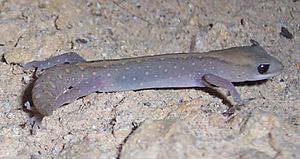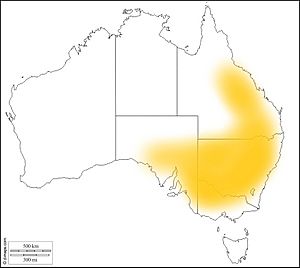Eastern stone gecko facts for kids
Quick facts for kids Eastern stone gecko |
|
|---|---|
 |
|
 |
|
| Conservation status | |
| Scientific classification | |
| Genus: |
Diplodactylus
|
| Species: |
vittatus
|
The Diplodactylus vittatus, also known as the eastern stone gecko, stone gecko, or wood gecko, is a type of gecko found in Australia. These geckos live in forests, bushy areas, and dry regions. You can find them across Queensland, Victoria, and New South Wales, especially in dry bushlands. Sometimes, people keep these geckos as pets or see them in zoos.
Contents
About the Eastern Stone Gecko
The eastern stone gecko is a small lizard that is active at night (this is called nocturnal). It lives on the ground in Australia (this is called terrestrial). This gecko has a dark brown body. It has pale, zigzag stripes that go from its back to the tip of its short, thick tail.
These geckos have four legs with special toes covered in tiny hairs called setae. They have large eyes with pupils that look like thin lines. They also have a fleshy tongue which they use to clean their eyes! Their bodies are soft, covered in tiny, bumpy scales, and they don't have eyelids. Their tail is very useful for many things. It helps them balance when they climb. It also stores fat, which is like their energy reserve. Plus, it helps them blend in with their surroundings.
An adult eastern stone gecko can grow up to 6 centimeters (about 2.4 inches) long from its nose to the start of its tail. From its nose to the tip of its tail, it can be about 9 centimeters (about 3.5 inches) long. These geckos usually live for about 5 years.
Where They Live
Eastern stone geckos are found in forests, shrublands (areas with lots of bushes), and semi-arid (partially dry) places. You can find them in Queensland, Victoria, New South Wales, and South Australia. They are often seen in dry bushlands, especially in areas with some trees. However, they usually avoid busy suburban areas.
Gecko Life and Home
The eastern stone gecko is an Australian reptile that is active at night and lives on the ground. During the day, when it's sunny, this gecko hides. It finds shelter in burrows or small dips under rocks or fallen logs. This is why it's often called the "stone gecko" or "wood gecko."
Like most reptiles, these geckos need their surroundings to control their body temperature. This is called thermoregulation. They will choose places to hunt for food that are between 17℃ and 26℃ (63℉ and 79℉). They also pick warmer spots to rest during the day. This helps them digest their food and helps female geckos develop eggs. If they can't control their body temperature well, they might lose energy. This could make them easier targets for predators. It could also make it harder for them to find food.
Eastern stone geckos rely a lot on plants, rocks, and fallen leaves or branches to survive. They use these environments to hide from danger. These places also provide their main food source. That's why you often find them in these kinds of locations.
These geckos talk to each other using sounds like clicking, chirping, and barking. They also use body language, like standing on their back legs. They use these ways to attract a mate or when male geckos are protecting their territory.
Reproduction and Life Cycle
The eastern stone gecko lays eggs (this is called oviparous). Their breeding season usually runs from September to February. The exact timing depends on where they live and the environment. A female gecko will lay two eggs at a time. She can lay several sets of eggs during one breeding season. Females lay their eggs in leaves, under bark, in burrows, or among other debris. Male geckos actively protect their territory. They use chirping, clicking, or barking sounds for this. These sounds can also help them attract a mate.
What They Eat
Eastern stone geckos are insectivores. This means they mostly eat insects. They hunt their prey by either catching it with their tongue or by closing their jaws around it. Their hunting activity depends on the temperature. They prefer to hunt when the air and ground temperatures are between 17℃ and 26℃ (63℉ and 79℉). This means they are most active when temperatures are falling, usually around dusk (evening).
Who Hunts Geckos
Larger reptiles, birds, snakes, frogs, and some mammals are predators of the eastern stone gecko. When a gecko feels threatened, it tries to scare its predator. It will open its mouth wide and stand on its back legs to look bigger. These geckos have also learned to blend in with their surroundings. They can even drop their tails to escape and get away from predators.
Threats to Geckos
Eastern stone geckos hunt mostly at dusk. This means they need to control their body temperature carefully. Climate change can make it harder for them to do this. This could affect their hunting activities. Losing their habitat and damage to their homes are also big threats to these geckos.
Images for kids




